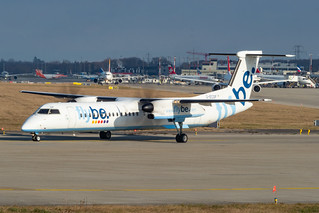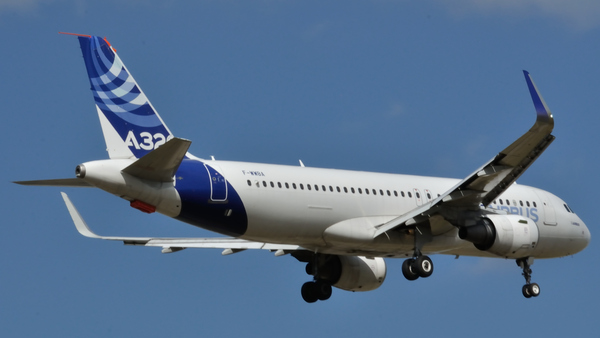Flybe DH8D near Dublin on Jul 31st 2015, smoke in cockpit, loss of communication
Last Update: June 20, 2016 / 20:31:51 GMT/Zulu time
Incident Facts
Date of incident
Jul 31, 2015
Classification
Incident
Cause
Smoke in cockpit
Airline
Flybe
Departure
Knock, Ireland
Destination
Manchester, United Kingdom
Aircraft Registration
G-FLBB
Aircraft Type
De Havilland Dash 8 (400)
ICAO Type Designator
DH8D
The airline reported a toilet smoke detector triggered.
On Jun 20th 2016 the AAIU released their final factual report without formal conclusion, however stating the engine manufacturer's conclusions:
high unbalance of the HP rotor resulted in distress of the carbon seals resulting in oil leak into the gas path
The AAIU stated that the aircraft was climbing through FL170, first officer was pilot flying, when the flight crew detected an unusual odour on the flight deck, checked the engine instruments and found the left hand engine's InterTurbine Temperature (ITT) was higher than the right hand engine's, however, was still within acceptable operational limits. Shortly after cabin crew informed the flight deck that a lavatory smoke detector had activated and there was visible smoke near the ceiling of the cabin. The flight crew levelled the aircraft at FL190, donned their oxygen masks, observed smoke on the flight deck apparently emanating from the panels to the left of the captain's (63, ATPL, 7,264 hours total, 2,354 hours on type) seat. The crew declared PAN, descended the aircraft to FL100 and explored nearest suitable airfields with ATC where to divert to, then decided to divert to Dublin. After landing the captain assessed, that an immediate evacuation was not necessary, emergency services did not detect any source of fire or heat, and the aircraft taxied to the apron, where passengers disembarked normally.
The source of the smoke could not be immediately identified.
Two days later, an operator's engineer intended troubleshooting and started the #1 engine for a low power engine run and was immediately alerted to a lot of smoke coming from an engine vent and the drain mast and shut the engine down. A large amount of engine oil was found in the engine's ducting, the oil quantity appeared low. A borescopic inspection identified an oil leak at the Handling Bleed-Off Valve (HBOV). The engine was removed and sent for overhaul.
The maintenance facility identified the #4 bearing key washer showed distress and concluded: "high unbalance of the HP rotor resulted in distress of the carbon seals resulting in oil leak into the gas path".
The AAIB reported the engine manufacturer took following actions:
On 26 January 2016, the Engine Manufacturer issued a Service Information Letter (SIL No. PW150-058) to all operators highlighting the root cause and preventative action to be taken.
The Engine Manufacturer identified that:
‘The distress condition of some washers, had resulted in metal chips being released into the oil system with possible symptoms being reported as loss of oil sealing, loss of oil pressure, cabin air contamination and in some cases In Flight Shut Down (IFSD) of the affected engine’
The cause of the washer wear (distress) was identified as stress in the filet radius of the key washer which may initiate cracks that could propagate until there is material release.
An improved key washer with an ‘infinite life’ was designed by the Engine Manufacturer and was made available from 29 February 2016. In the interim period until such replacements were made, the Engine Manufacturer developed and implemented several actions aimed to reduce the incidence of events related to the distress of the Key washer component.
The AAIU commented that the crew actions were appropriate, the necessary actions were taken.
The AAIU further commented: "The Engine Manufacturer has identified the cause of the No. 4 Bearing Key washer distress and issued guidance for inspection and replacement of the part. In addition, the part has been redesigned for an ‘infinite life’ on replacement and accordingly this Investigation does not sustain any Safety Recommendations."
Incident Facts
Date of incident
Jul 31, 2015
Classification
Incident
Cause
Smoke in cockpit
Airline
Flybe
Departure
Knock, Ireland
Destination
Manchester, United Kingdom
Aircraft Registration
G-FLBB
Aircraft Type
De Havilland Dash 8 (400)
ICAO Type Designator
DH8D
This article is published under license from Avherald.com. © of text by Avherald.com.
Article source
You can read 2 more free articles without a subscription.
Subscribe now and continue reading without any limits!
Read unlimited articles and receive our daily update briefing. Gain better insights into what is happening in commercial aviation safety.
Send tip
Support AeroInside by sending a small tip amount.
Related articles
Flybe DH8D at Manchester on Sep 4th 2019, engine shut down in flight
A Flybe de Havilland Dash 8-400, registration G-FLBB performing flight BE-817 from Manchester,EN to Isle of Man (UK) with 38 people on board, was…
Flybe DH8D near Birmingham on Dec 8th 2016, loss of cabin pressure
A Flybe de Havilland Dash 8-400, registration G-FLBB performing flight BE-455 from Manchester,EN to Jersey,CI (UK) with 23 passengers and 4 crew, was…
Flybe DH8D at Newquay on Nov 14th 2019, aileron cable broke
A Flybe de Havilland Dash 8-400, registration G-FLBE performing flight BE-2187 from Newquay,EN to London Heathrow,EN (UK) with 59 passengers and 4…
Flybe E195 at Exeter on Feb 28th 2019, rejected takeoff due to haze on board as result of maintenannce prompts evacuation
A Flybe Embraer ERJ-195, registration G-FBEJ performing flight BE-4321 from Exeter,EN (UK) to Alicante,SP (Spain) with 100 passengers and 5 crew, had…
Flybe DH8D near BIrmingham on Jul 22nd 2019, cabin pressure problems
A Flybe de Havilland Dash 8-400, registration G-PRPK performing flight BE-1331 from Edinburgh,SC to London City,EN (UK) with 56 passenges and 4 crew,…
Flybe DH8D near Manchester on Nov 22nd 2019, engine shut down in flight
A Flybe de Havilland Dash 8-400, registration G-ECOF performing flight BE-774 from Southampton,EN to Edinburgh,SC (UK) with 69 people on board, was…
Flybe DH8D near Exeter on Nov 15th 2018, altitude disagree
A Flybe de Havilland Dash 8-400, registration G-JECR performing flight BE-3501 from Exeter,EN (UK) to Paris Charles de Gaulle (France), was enroute…
Newest articles
Wizz UK A21N at Prague on Sep 11th 2025, tail strike on landing
A Wizz Air UK Airbus A321-200N, registration G-XLRA performing flight W9-5775 from London Gatwick,EN (UK) to Prague (Czech Republic), landed on…
PIA A320 at Lahore on Jan 17th 2025, landed on wrong runway
A PIA Pakistan International Airlines Airbus A320-200, registration AP-BON performing flight PK-150 from Dammam (Saudi Arabia) to Multan (Pakistan)…
Subscribe today
Are you researching aviation incidents? Get access to AeroInside Insights, unlimited read access and receive the daily newsletter.
Pick your plan and subscribePartner

ELITE Simulation Solutions is a leading global provider of Flight Simulation Training Devices, IFR training software as well as flight controls and related services. Find out more.
SafetyScan Pro provides streamlined access to thousands of aviation accident reports. Tailored for your safety management efforts. Book your demo today
AeroInside Blog
Popular aircraft
Airbus A320Boeing 737-800
Boeing 737-800 MAX
Popular airlines
American AirlinesUnited
Delta
Air Canada
Lufthansa
British Airways














